
The northerly route was replaced in May 1931 by the Athens - Corfu - Naples - Genoa route flown by the new Short Kent class flying boats.
From October 1931, Brindisi - Paris was by rail and the planes flew from Athens to Haifa, no longer flying via Egypt. That change meant that the Kent flying boats now flew over Cyprus on the Athens - Castelrosso - Haifa section.
For the London - India flight leaving London on 16 April, 1932 Castelrosso was replaced by stops at Rhodes and at Limassol in Cyprus with the first arrivals on 19 April.
For the flight leaving London on 1
October 1932, Rhodes and Limassol were dropped and the route reverted to being via Castelrosso.
The route was also changed from the
Persian to the Arabian side of the Persian Gulf.
Changed route: May 1931
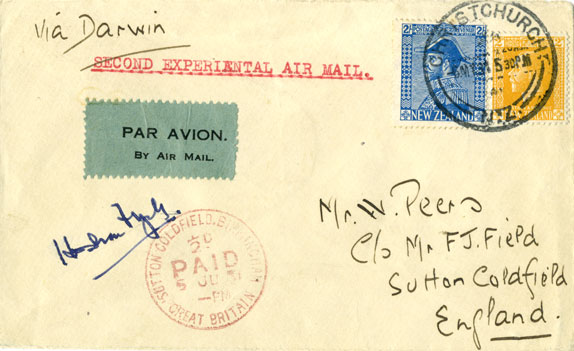
The northerly route was replaced in May 1931 by the Athens - Corfu - Naples - Genoa route flown by the new Short Kent class flying boats.
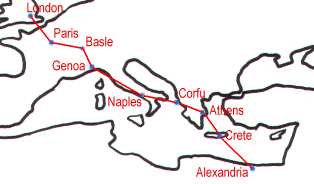
This was the route taken by the return of the second experimental flight between the UK and Australia. This cover is postmarked in New Zealand on 5 May and joined the experimental flight at Sydney on 16 May.
The mail connected with the scheduled flight IW 112 from Delhi on May 27 and was flown to Cairo where it arrived on 30 May.
It was due to arrive in Genoa on June 1, but
the flight was delayed for two days in Corfu [1] and so it
was June 3 before it arrived in Genoa.
The mail was sent by overnight rail from Genoa to Basle
and then flown to London where it arrived on 4 June [1,4].

Flown Delhi - UK
This cover is postmarked in Calcutta on 21 June, 1931. It has routing instructions to be sent by surface to Delhi where it would join IW 116 that left Delhi on 24 June and arrived in London on 30 June [1].
It is franked with 10 annas as the air mail rate from Delhi was 2 annas greater than the rate from Karachi.
This route did not last very long.
Due to further problems with flying over Italy, on 17 October 1931
the route was again changed.
The journey from Paris to Brindisi
in the south of Italy was now by train.
Changed route, 17 October 1931, no longer via Egypt
Previously, the London - India and London - Africa services only separated in Egypt. There were now two completely different services from London with the Indian service leaving on a Saturday and the African service on a Wednesday.

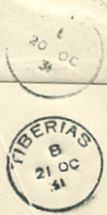
After arriving in Brindisi by train from Paris, the mail on the Indian route was now flown by Kent flying boats from Brindisi to Athens via Corfu and then, instead of flying from Athens to Alexandria, Egypt was omitted from the route which was now via Castelrosso to Haifa followed by a car journey (by Nairn Transport) to Tiberias. From Tiberias DH 66 Hercules landplanes flew to Karachi. The DH 66 were based in Cairo and this provided an airlink between Tiberias and Cairo.
This cover to Tiberias was flown on the first flight, IE 134, on the new route
and is correctly franked with 3½d.
It left Croydon on 17 October and arrived in Haifa on 20 October where a (faint) backstamp
was applied..
It was then carried by Nairn Transport to Tiberias on 20 October and backstamped on
21 October.
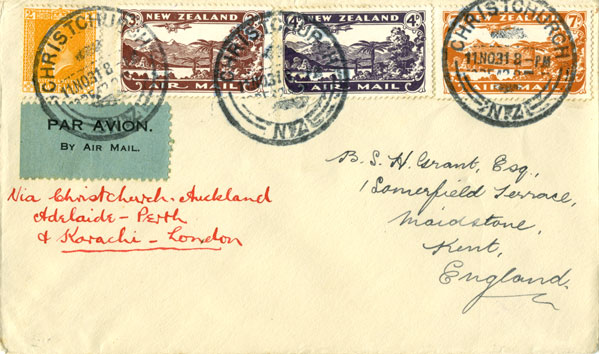
Acceptance from New Zealand
This cover is franked with the complete set of the first New Zealand airmail stamps.
As well as being flown Karachi - London on flight IW 140 on 10 - 17 December 1931, it has routing instructions for it also to be flown Christchurch - Auckland on the special New Zealand internal Christmas flight of 12 November; and Adelaide - Perth on 21-22 November.
The franking is correct.
The 3d pays for the internal New Zealand flight, the 4d for Adelaide - Perth and the 7d
for Karachi - London.
In addition, the 2d GV covers the surface rate.

Introduction of Hannibal class aircraft
Handley Page HP 42E Hannibal aircraft were introduced to the Cairo - Karachi section at this time. Horsa, Hadrian, Hanno and Hannibal flew out to Cairo from Croydon during November and December 1931.
A Real Photograph postcard from the 1930s and showing G-AAXF Helena is shown.
The Hannibal class aircraft could carry 24 passengers, but
were quite slow with a cruising speed of only 100 mph.
They remained in service until September 1939 when they
were taken over by the RAF.
During their time with Imperial Airways they
were not involved in any major accidents.
to Germany, flown Delhi - Brindisi
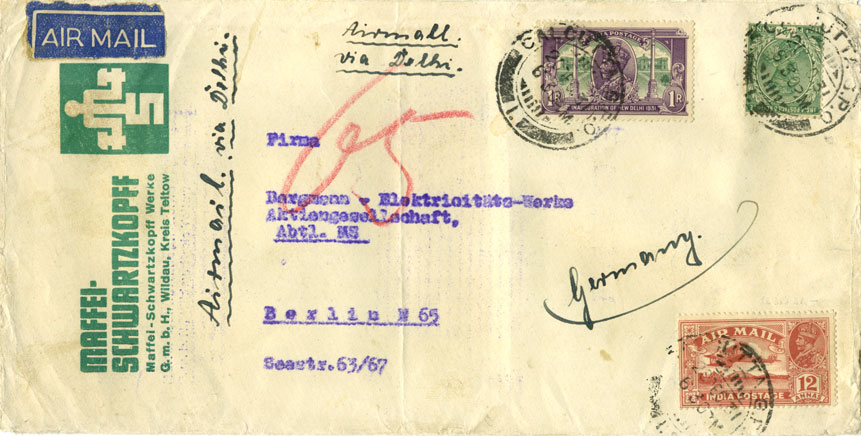
This cover is postmarked at 5.30 pm on 20 December 1931 in Calcutta and is addressed to Berlin. It went from Calcutta to Delhi by rail and is unlikely to have arrived in time to be on the flight that left Delhi early in the morning of 22 December. If that was the case then it would have been flown on the flight that left on 29 December. It would be flown to Brindisi in Italy. As the Brindisi - Paris section was by rail, this cover is likely to have left the regular service at Brindisi and carried directly to Germany by rail.
The flight from Delhi to Karachi on 29 December was the last flight before that section was taken over by the Delhi Flying Club.
Delhi Flying Club, January 1932
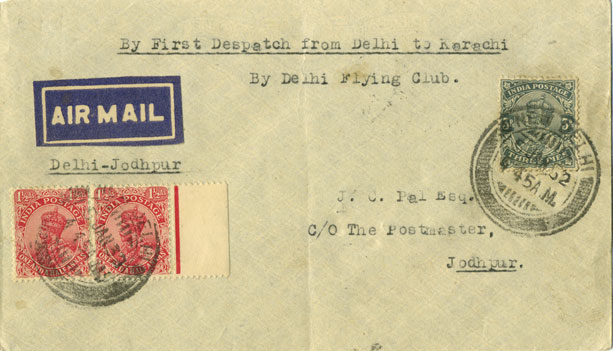
From 3 January 1932 until July 1933, the Karachi - Delhi route was operated by the Delhi Flying Club [3].
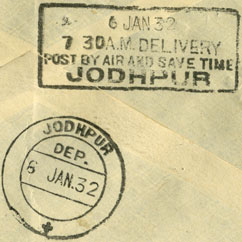
This cover is one of only 16 flown on the Delhi - Jodhpur leg of the first flight by the Delhi Flying Club on 5 January. It has Jodhpur arrival backstamps on 6 January, one timed at 7.30 am.
Delhi - Johannesburg, first acceptance of airmail India - South Africa, January 1932
The first regular London - Cape Town airmail had left Croydon Airport on 20 January 1932 and mail was accepted from India.
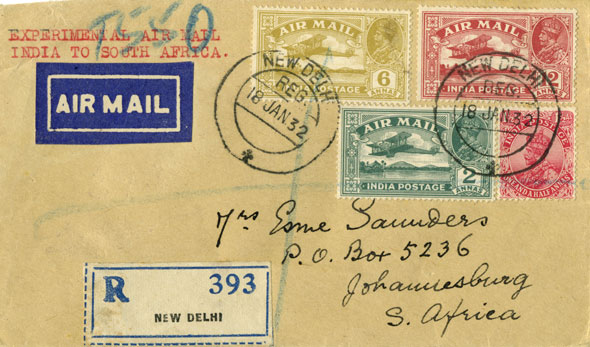
The example cover is postmarked New Delhi on 18 January 1932 and was flown from Delhi to Karachi on the third flight of the Delhi Flying Club service.
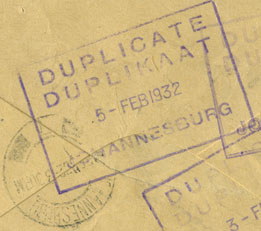
The mail was then flown by Imperial Airways from Karachi on the India - London service on 20 -22 January to Tiberias where the London mail was off-loaded. According to Wingent [1], the plane was Hadrian, an HP 42.
The mail for Africa remained on the HP 42 and was flown to Cairo on 23 January to join the London - Cape Town service. The mail arrived in Johannesburg on 1 February and in Cape Town on 2 February.
As well as having a Johannesburg backstamp, the shown cover has three DUPLICATE DUPLIKAAT backstamps dated in turn 3, 4 and 5th February. This cover is one of only 40 acceptances of mail from India to Johannesburg on the first flight.
The surface rate for mail from India had been increased on 31 December from
2 annas to 2½ annas.
The air mail fee from India to South Africa was 14 annas plus 2 annas if flown from Delhi.
That was in addition to the surface rate giving a total charge of 18½ annas.
The cover is franked with 21½ annas which leaves 3 annas as the registration fee.
The service by the Delhi Flying Club ceased
when the route was extended to Calcutta
in July 1933.
The leg from Karachi to Calcutta via Delhi was operated by
Indian Trans-Continental Airways (ITCA)
in conjunction with Imperial Airways.
via Rhodes and Cyprus, April 1932
London - Cyprus, 16-19 April
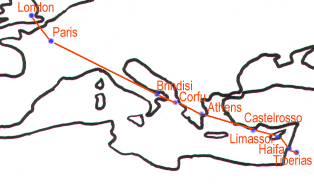
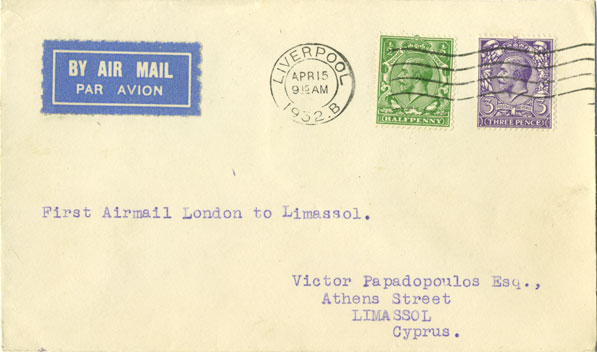
From April 1932, a stop was made in Rhodes and in Cyprus on the regular Imperial Airways London - India airmail service.
This cover is postmarked on 15 April 1932. It was flown on the first flight IE 160 from London to Limassol on 16 - 19 April.
The inclusive airmail fee from London to Cyprus was 3½d for the first ½oz.
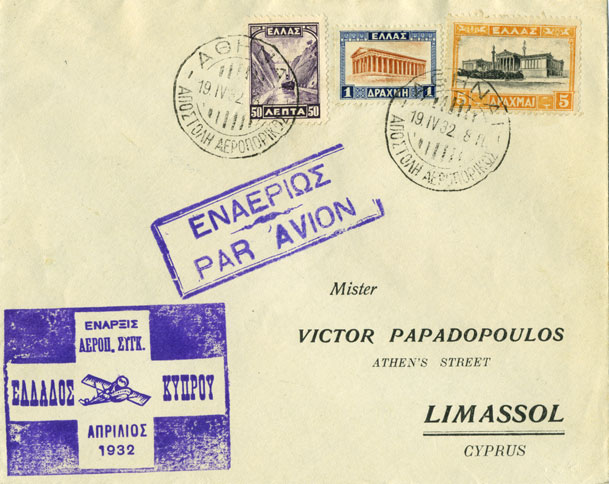
Athens to Limassol leg, 19 April
The next cover was flown on the Athens to Limassol leg. It is postmarked 19 April, the day of the flight.
It has a Greek cachet in blue-purple to commemorate the first airmail between Greece and Cyprus.
I have seen a cover with the inscription By First Air Mail London - Rhodes
datestamped in London on 14 May. However it has an Athens transit on 16 May
and the arrival datestamp is 23 May suggesting that it was only flown as far as Athens.
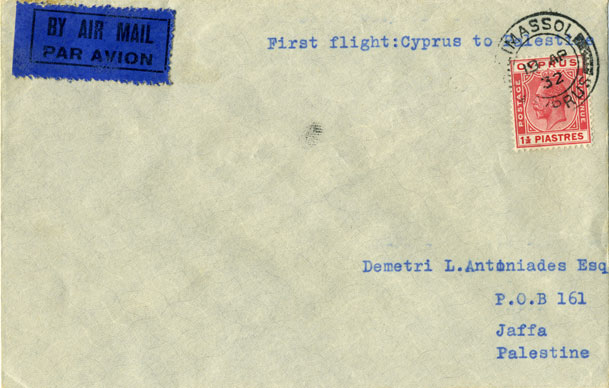
Cyprus - Palestine
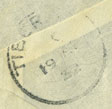
The next cover is addressed to Jaffa in Palestine. By this time, the flying boats did not fly to Haifa, but flew straight through to the Sea of Galilee (Tiberias). The cover is postmarked in Limassol on 19 April and flown to Tiberias where it was backstamped on 19 April. It would then continue to Jaffa by surface transport.
The airmail surcharge was 1 piastre on top of the surface rate of ½ piastre.
At Tiberias, the mail for India was transferred to a Handley Page HP42
and flown to Baghdad.
Return flight
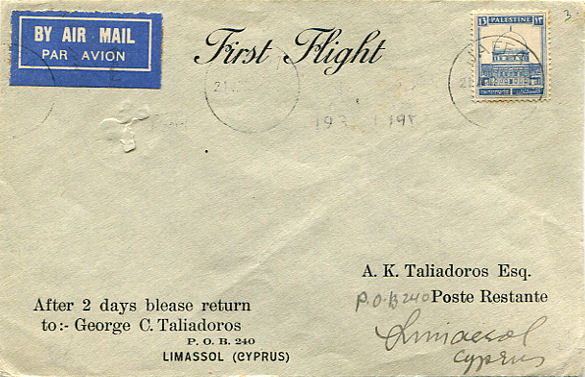
Palestine - Cyprus leg, 24 April
The first flight IW 159 in the opposite direction left Tiberias for Cyprus on 24 April.
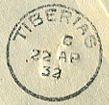
This cover is postmarked in Jaffa on 21 April and is addressed to Limassol. It has a Tiberias transit mark on 22 April and would be flown to Cyprus on Sunday 24 April.
The schedule was to leave Tiberias early on a Saturday morning, fly to Cyprus which was then left mid morning, fly to Rhodes which was left in the early afternoon and finally arrive in Athens in the evening.
However the first flight was a day late due to high winds in Basra delaying the HP 42 Hadrian
which did not arrive in Tiberias until the evening of Saturday 23 April.
The mail was therefore not flown from Tiberias to Limassol on the flying boat Sylvanus
until Sunday 24 April.

Cyprus - Rhodes leg, 24 April
The next cover is addressed to Rhodes and was flown on the Cyprus - Rhodes leg on 24 April.
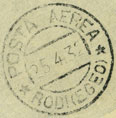
Although the cover arrived in Rhodes on 24 April, it was not backstamped until the next day, 25 April.
The airmail surcharge from Cyprus to Rhodes was 1 piastre.

Cyprus - Athens leg, 24 April
The next cover is registered and is addressed to Greece. It is postmarked 22 April and was flown on the Cyprus - Greece leg on 24 April.
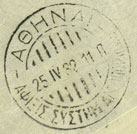
It has a commemorative cachet with a similar design, but different inscription from the one shown earlier. Again, the arrival backstamp was applied on the following day.
The airmail surcharge from Cyprus to Greece was 1 piastre.
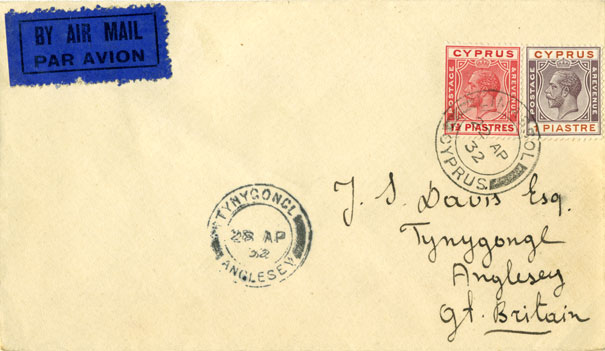
Cyprus - London, 24 -27 April
The final cover was flown from Cyprus to London from 24 to 27 April. The cover has an Anglesey (Wales) receiving mark on the front dated 28 April.
The airmail surcharge from Cyprus to London was 2 piastres on top of the surface rate of ½ piastre.
Starting with the flight leaving London on 1 October 1932,
both Limassol and Rhodes were dropped from the route and the
Kent flying boats flew via Castelrosso.
First acceptance from New Zealand for IA African Service June 1932

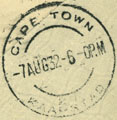
Along with the inclusion of Cyprus in April 1932, the Tiberias to Cairo link service was changed to include a stop at Ramleh in Palestine.
From June 1932, air mail was accepted from New Zealand for Africa. It was carried to Karachi by surface mail and flown from there. Mail on the first acceptance left Karachi on 27 July and arrived in Tiberias (Galilee) on 29 July.
At Tiberias, the mail for London was unloaded so that it could be flown to Athens by Kent flying boat. However, as the HP 42s were based in Cairo, the mail for Africa remained on the plane at Tiberias and was flown from there to Cairo on 30 July.
At Cairo, the mail joined the London - Cape Town service
on 31 July and arrived in Cape Town on 7 August.
Ramleh - Baghdad Auxiliary Service, August 1932
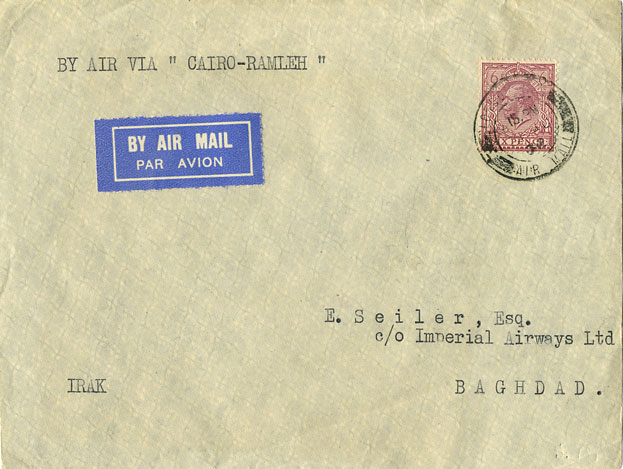

The airmail for Karachi left Croydon on a Saturday while the airmail for Africa left on a Wednesday. From the flight that left Croydon on Wednesday 31 August, mail for Iraq was accepted on the African service.
It arrived in Alexandria on 3 September and was then taken from there to Ramleh in Palestine via Cairo by rail. It was then flown from Ramleh to Baghdad via Rutbah on Monday 5 September [1]. This meant that there were now two services each week from the UK to Iraq.
This cover is postmarked on 31 August and was flown on the first service.
The service did not last very long and was ended in November 1932 [1].
Via Bahrain and Sharja, 1 October 1932
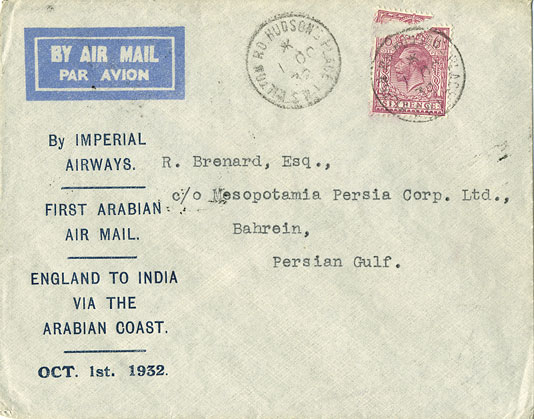
For flight IE184 leaving London on 1 October 1932, the route was changed from the Persian to the Arabian side of the Persian Gulf. The route from Basra to Karachi was now via Sharjah, Bahrein and Gwadar. A stop in Kuwait was added in January 1933.
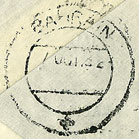
Another change was that Rhodes and Limassol were dropped from the route from Athens and replaced by Castelrosso. Also, the car journey from Haifa to Tiberias was no longer necessary as the Kent flying boats now flew to Lake Tiberias (Sea of Galilee) where passengers were transferred to the HP 42 airliners.
This cover is postmarked in London on 1 October and is addressed to Bahrein
which was reached one day late on 7 October.
It was backstamped Bahrain on 7 October.

Acceptance from New Zealand for Karachi - London
The first flight from Karachi on the new route left on 5 October and arrived in London on 12 October.
This cover is postmarked in Wellington on 22 September and, as it was redirected, has a London postmark on 25 October. The cover was carried from New Zealand to Karachi by surface before being flown on the third flight (IW185) on the new route from Karachi which left on 19 October and arrived in London on 25 October.
It would go on the Maunganui that left Auckland on 23 September and arrived in Sydney on 27 September. It then went on the Cathay from Fremantle to Colombo and was scheduled to connect with IW 185.
The surface rate had been reduced back to 1d in the middle of 1932
and so the cover is correctly franked with 7d for Karachi - London and 1d surface.
All scans were made by the author.
Information is taken from:
[1] Aircraft Movements on Imperial Airways' Eastern Route,
Vol 1, 1927 - 1937, Peter Wingent, Winchester 1999.
[2] British External Airmails until 1934 (2nd Edition),
A S Newall, 1996.
[3] Airmails of New Zealand, volume 2 (1986) compiled by
Douglas A Walker,
Air Mail Society of New Zealand
[4] The Postal History of British Airmails, E B Proud,
1991.